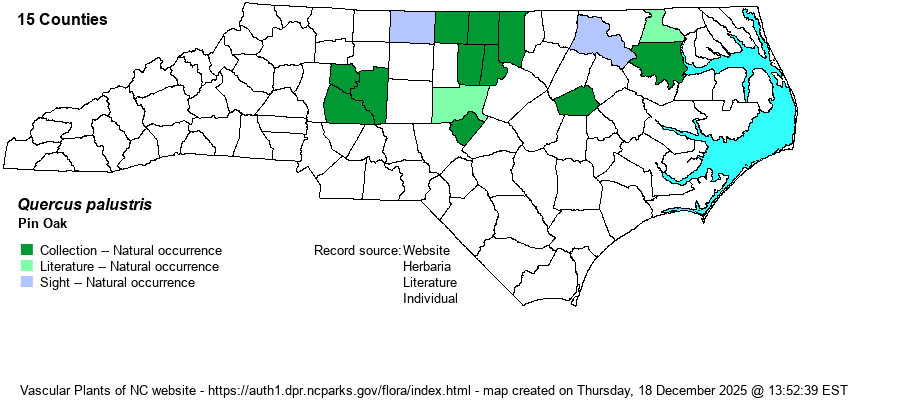| Author | Muenchhausen | |
| Distribution | Widely scattered over the northeastern half of the Piedmont, and sparingly into the northwestern Coastal Plain, south to Wilson County (a recent swamp forest collection at NCU). Apparently no confirmed records for the Mountains, though there are a few reports, and reports and collections from the western Piedmont seem to refer to planted trees. Ranges eastward to Hertford and Bertie counties and south to Lee County, and west to Davie and Rowan counties. The many photos in iNaturalist are not accepted here, as so many are either misidentified or are likely planted individuals.
This is a Northern and Midwestern species, ranging from New England and IA, south sparingly to SC and OK. Though found in most counties in states from OH west to MO, as well as most of VA, it is spottily distributed in NC and TN southward.
| |
| Abundance | Mysteriously scarce in the state, considering its available habitats. It is rare and local, and apparently has declined considerably, perhaps to habitat loss (by flooding of Triassic Basin floodplains for creation of Falls and Jordan lakes). Seldom are more than a few individuals seen at any given site. Though it is frequently planted along city and town streets, thankfully it generally does not escape and confuse geographers as to which sites are natural or not. This is an NC Watch List species. | |
| Habitat | This species is typically found in NC in Piedmont swamps, or other slightly wet areas within bottomlands; surprisingly, it is not normally found in the Floodplain Pool natural community. In floodplains, it typically grows near the swamp margins, or in the wetter spots. It can occur in similar forested pools and damp sites as Swamp White Oak (Q. bicolor), also a rare species in the state, but that species seems more restricted to high pH soils. |
| Phenology | Flowers from March to May, and fruits from September to November of the second year. | |
| Identification | This tree is familiar to biologists farther north and northwest of NC, but most probably have not seen it “in the wild” in the state. It is a medium deciduous tree, growing mostly just to 65-70 feet tall, with an odd arrangement of branches. Trees in more open places show distinctly downward drooping lower branches, whereas those in the middle are horizontal, and upper branches angle upward. Few other trees show such downward angling lower branches. However, in heavy shade of deep forests, this pattern may not be obvious. The leaves are smaller than most other similar “red oak” species, being about 4 inches long and 3-4 inches wide. The sinuses are very deep and rounded, cut nearly to the midrib, leaving often just five (to at times seven) lobes. Also, the leaf base is straight and almost perpendicular to the midrib. It can be easily confused with Shumard Oak (Q. shumardii), which also grows in bottomlands and can be found with Pin Oak; that species has larger leaves with normally seven lobes, and the sinuses are usually deep but not quite cut to the midrib. You may need to check the limbs –- Shumard does not have lower limbs angling downward -– and any acorns, as Shumard has very large acorns and Pin has tiny (only about 1/2-inch across) acorns. As with many or most oak identifications, check leaves from the upper part of the tree, or at least leaves from several parts of the tree, and do rely on just a single leaf for confirmation. | |
| Taxonomic Comments | None
| |
| Other Common Name(s) | Swamp Spanish Oak (very poor name, as it is also used for Q. pagoda) | |
| State Rank | S2 | |
| Global Rank | G5 | |
| State Status | W1 | |
| US Status | | |
| USACE-agcp | FACW link |
| USACE-emp | FACW link |

